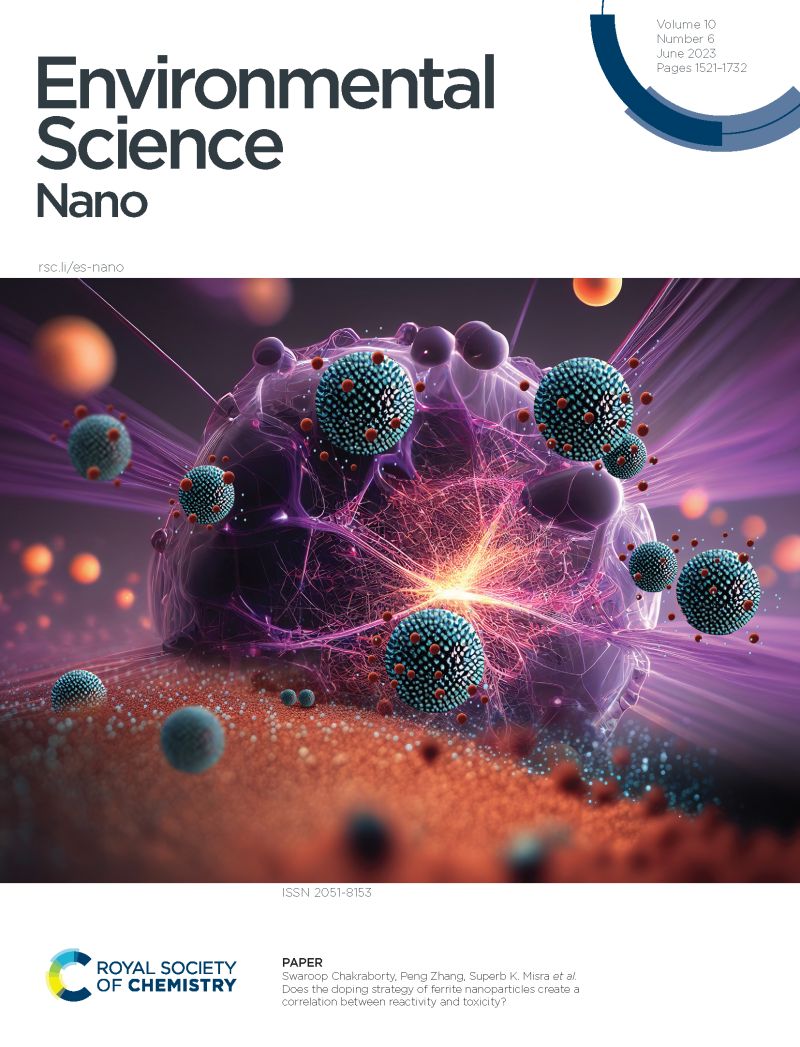Iron oxide nanoparticles as effective nano-fertilizer for alleviating arsenic toxicity in barley: physiological and molecular mechanisms
IF 5.8
2区 环境科学与生态学
Q1 CHEMISTRY, MULTIDISCIPLINARY
引用次数: 0
Abstract
Arsenic (As) contamination in soils posed a significant threat to sustainable agriculture and food safety. The application of metal nanoparticle (MNP) technology in alleviating heavy metal toxicity is an emerging and promising field. However, little has been known about the effect of FeO-NPs in alleviating As toxicity and accumulation in plants. In this study we examined the roles of FeO-NPs in promoting barley growth and alleviating As toxicity. Exposure of plants to As stress (100 μM As) severely reduced growth and photosynthesis, and also caused disorder of other physiological traits, including enhanced oxidative stress and nutrient imbalance. Addition of FeO-NPs (20 and 100 mg L-1) into the nutrient solution containing As significantly alleviated As toxicity of the two barley genotypes, mainly reflected by better plant growth, higher photosynthetic rate, and lower AOS (active oxygen species) content. As toxicity and genotypic difference between BCS-158 (As tolerant) and BCS-016, As sensitive) are closed related to As uptake and accumulation in plant tissues, with BCS-158 having lower As concentrations in both roots and shoots than BCS-016. Addition of FeO-NPs dramatically reduced As uptake and accumulation in the plants exposed to As treatment, thus resulting in alleviation of As toxicity. The reduction of As uptake and accumulation in the plants subjected to FeO-NPs is attributed to upregulating expression of iron transporter genes (HvIRT1 and HvIRT2) and suppressing expression of arsenic transporter genes (HvLsi1 and HvLsi2). The current results show the potential of FeO-NPs application in As-contaminated soils for improving crop production and food safety, but more research should be done to evaluate its ecological risk and determine the optimal doses before they are efficiently applied in crop production.氧化铁纳米颗粒作为减轻大麦砷毒性的有效纳米肥料:生理和分子机制
土壤砷污染对可持续农业和食品安全构成重大威胁。金属纳米颗粒(MNP)技术在减轻重金属毒性方面的应用是一个新兴的、有前景的领域。然而,FeO-NPs在减轻植物砷毒性和积累方面的作用知之甚少。在这项研究中,我们研究了FeO-NPs在促进大麦生长和减轻砷毒性中的作用。在100 μM的砷胁迫下,植物的生长和光合作用受到严重影响,氧化应激加剧,营养失衡等生理性状也受到影响。在含As的营养液中添加FeO-NPs(20和100 mg L-1)显著减轻了两种基因型大麦的As毒性,主要表现为植株生长较好、光合速率较高、活性氧含量较低。BCS-158 (As耐受性)和BCS-016 (As敏感)的As毒性和基因型差异与植物组织对As的吸收和积累密切相关,BCS-158根和芽中的As浓度均低于BCS-016。添加FeO-NPs可显著降低砷处理下植物对砷的吸收和积累,从而减轻砷毒性。FeO-NPs处理下植物砷吸收和积累的减少是由于铁转运基因(HvIRT1和HvIRT2)的表达上调和砷转运基因(HvLsi1和HvLsi2)的表达抑制。目前的研究结果表明,FeO-NPs在砷污染土壤中的应用具有改善作物生产和食品安全的潜力,但在有效应用于作物生产之前,还需要进行更多的生态风险评估和最佳剂量确定研究。
本文章由计算机程序翻译,如有差异,请以英文原文为准。
求助全文
约1分钟内获得全文
求助全文
来源期刊

Environmental Science: Nano
CHEMISTRY, MULTIDISCIPLINARY-ENVIRONMENTAL SCIENCES
CiteScore
12.20
自引率
5.50%
发文量
290
审稿时长
2.1 months
期刊介绍:
Environmental Science: Nano serves as a comprehensive and high-impact peer-reviewed source of information on the design and demonstration of engineered nanomaterials for environment-based applications. It also covers the interactions between engineered, natural, and incidental nanomaterials with biological and environmental systems. This scope includes, but is not limited to, the following topic areas:
Novel nanomaterial-based applications for water, air, soil, food, and energy sustainability
Nanomaterial interactions with biological systems and nanotoxicology
Environmental fate, reactivity, and transformations of nanoscale materials
Nanoscale processes in the environment
Sustainable nanotechnology including rational nanomaterial design, life cycle assessment, risk/benefit analysis
 求助内容:
求助内容: 应助结果提醒方式:
应助结果提醒方式:


